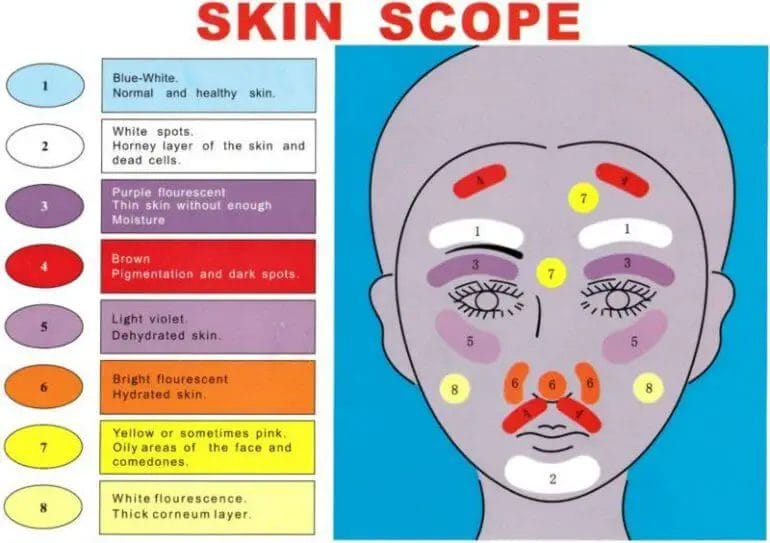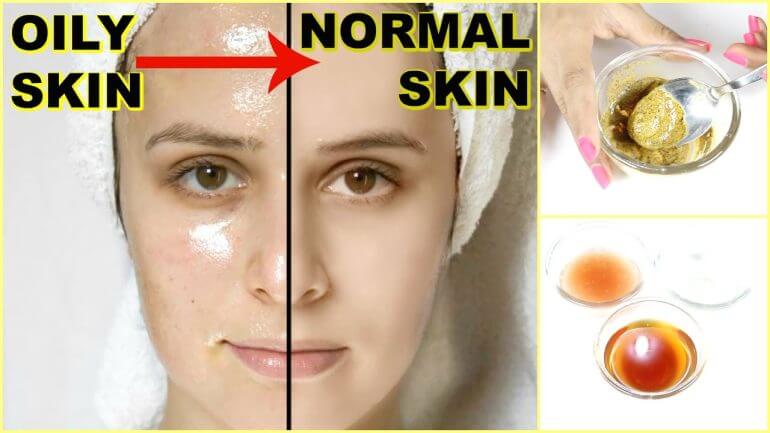Oily skin can be easily identified under a Wood’s lamp due to its distinctive appearance. When exposed to the UV light emitted by the lamp, oily skin appears as a shiny, reflective surface. This is because the excess sebum produced by the skin reflects the light, giving it a greasy and glossy appearance. By using a Wood’s lamp, skincare professionals can assess the level of oiliness in the skin and tailor their treatments accordingly.

Revealing Oily Skin: The Role of Wood’s Lamp in Skin Analysis
When it comes to understanding our skin, there are various tools and techniques available to dermatologists and estheticians. One such tool is the Wood’s lamp, also known as a blacklight. This device emits a specific wavelength of ultraviolet (UV) light that can reveal different aspects of the skin, including oily areas.

The main advantage of using a Wood’s lamp for skin analysis is its ability to highlight sebum production. Sebum is an oil produced by our skin’s sebaceous glands. While sebum is necessary to keep our skin moisturized and protected, an excessive amount can lead to oily skin, clogged pores, and even acne breakouts.
During a Wood’s lamp examination, the UV light illuminates the skin, making various substances fluoresce differently. Sebum tends to appear yellow or orange under the Wood’s lamp, making it easy to identify areas of excessive oiliness. This information is valuable for skincare professionals as it helps in the development of customized treatment plans for individuals dealing with oily skin concerns.
Additionally, the Wood’s lamp can also reveal other skin conditions that may coexist with oily skin. For example, it can highlight areas of hyperpigmentation, which are darkened patches of skin caused by an overproduction of melanin. Identifying these areas can aid in selecting appropriate treatment options such as topical creams or laser therapies.
Furthermore, the Wood’s lamp is instrumental in evaluating the effectiveness of skincare products designed to target oily skin. By examining the skin before and after product application, professionals can determine if the treatment has successfully reduced sebum production or if additional adjustments are necessary.
How to Prepare for a Wood’s Lamp Analysis
If you are planning to undergo a Wood’s lamp analysis to assess your oily skin, there are a few steps you can follow to ensure accurate results:
- Cleanse your face thoroughly and remove any makeup or skincare products.
- Avoid applying any creams, lotions, or oils that can interfere with the examination.
- Make a note of any specific areas of concern or problem areas on your skin that you would like the professional to focus on.
Benefits and Limitations of Wood’s Lamp Analysis
Wood’s lamp analysis offers several benefits in assessing oily skin:
- Provides a visual representation of sebum distribution on the skin.
- Aids in identifying areas of hyperpigmentation.
- Assists in evaluating the effectiveness of skincare products and treatments.
However, it is important to note that Wood’s lamp analysis has its limitations:
- It cannot diagnose specific skin conditions or diseases.
- Results can vary based on individual skin characteristics and lighting conditions.
In Summary
A Wood’s lamp analysis is a useful tool in the field of skin analysis, particularly for those with oily skin concerns. By revealing areas of excessive sebum production, it helps professionals develop tailored treatment plans to address oily skin and associated conditions. However, it should be used in conjunction with other diagnostic methods for a comprehensive evaluation of the skin. If you are considering a Wood’s lamp analysis, consult with a qualified skincare professional to guide you through the process and interpret the results accurately.

Characteristics of Oily Skin Under a Wood’s Lamp: What to Look for
A Wood’s lamp, also known as a black light, is a tool commonly used by dermatologists and estheticians to examine the skin closely. It emits a specific wavelength of ultraviolet light that can reveal certain skin conditions and characteristics that are not visible to the naked eye. When it comes to oily skin, using a Wood’s lamp can provide valuable insights into the skin’s condition and help determine the appropriate skincare regimen.
Here are some key characteristics of oily skin that can be observed under a Wood’s lamp:
1. Shine
Oily skin tends to have a noticeable shine, especially on the T-zone area (forehead, nose, and chin). When examined under a Wood’s lamp, the oil on the skin’s surface will appear fluorescent, reflecting the UV light. This shine is caused by excess sebum production.
2. Enlarged Pores
People with oily skin often have visibly enlarged pores. This is because the excess sebum produced by the sebaceous glands can clog the pores, causing them to stretch and appear larger. Under a Wood’s lamp, these enlarged pores will be more apparent and can help determine the severity of the oiliness.
3. Acne and Blackheads
Oily skin is prone to acne and blackheads due to the excess oil and sebum that can clog the pores. When examined under a Wood’s lamp, these acne lesions will often appear as fluorescent spots, indicating the presence of bacteria or clogged pores. It can help identify the areas that require targeted treatment.
4. Thickened Epidermis
Another characteristic of oily skin is a thickened epidermis, the outermost layer of the skin. The excess oil production can cause the skin to become thicker and more resistant. Under a Wood’s lamp, this thickened epidermis may appear as rough or yellowish patches on the skin.
5. Sensitivity to UV Light
Oily skin can be more sensitive to UV light exposure. When examined under a Wood’s lamp, areas of the skin that have been exposed to the sun without proper protection may appear darker or show signs of hyperpigmentation. This sensitivity highlights the importance of using sunscreen and taking appropriate sun protection measures for oily skin.
Understanding the characteristics of oily skin under a Wood’s lamp can help individuals and skincare professionals develop customized skincare routines and treatment plans. By addressing these specific concerns, it is possible to manage and improve the condition of oily skin effectively.

Assessing the Severity of Oiliness: Interpreting Wood’s Lamp Results
Wood’s Lamp examination is a commonly used diagnostic tool in dermatology to evaluate various skin conditions. It utilizes ultraviolet light to highlight certain skin abnormalities, such as oiliness. By interpreting the Wood’s Lamp results, dermatologists can assess the severity of oiliness and determine the appropriate treatment plan for their patients.
During the Wood’s Lamp examination, a handheld lamp emitting ultraviolet light is used to illuminate the patient’s skin. Oiliness appears as a yellow or orange fluorescence under the Wood’s Lamp, which helps identify areas of increased sebum production. The severity of oiliness can be evaluated based on the intensity and extent of fluorescence observed.
When interpreting the Wood’s Lamp results, dermatologists take into consideration several factors:
1. Intensity of Fluorescence:
The intensity of fluorescence under the Wood’s Lamp indicates the amount of oil present on the skin. A higher intensity of fluorescence suggests more severe oiliness. Dermatologists may use a grading system to classify the intensity of fluorescence, such as mild, moderate, or severe.
2. Distribution of Oiliness:
The distribution of oiliness on the skin can also provide insights into its severity. If oiliness is localized to certain areas, it may indicate a milder form of oiliness. On the other hand, widespread oiliness across the face or other body parts may suggest a more severe condition.
3. Presence of Comedones:
Comedones, commonly known as blackheads and whiteheads, are a common manifestation of oiliness. Their presence under the Wood’s Lamp can further indicate the severity of oiliness. Numerous comedones may suggest a more severe form of oiliness.
4. Patient Symptoms:
The dermatologist also takes into account the patient’s symptoms and complaints related to oiliness. Excessive sebum production may lead to a greasy appearance, acne breakouts, and enlarged pores. The severity of these symptoms can help gauge the severity of oiliness.
Based on the interpretation of the Wood’s Lamp results and consideration of other factors, dermatologists can develop a customized treatment plan for patients with oiliness. Treatment options may include topical medications, such as retinoids or salicylic acid, to regulate sebum production and unclog pores. Additionally, lifestyle modifications and proper skincare routines may be recommended to manage oiliness effectively.
Summary
The Wood’s Lamp examination is a valuable tool in assessing the severity of oiliness. By evaluating the intensity of fluorescence, distribution of oiliness, presence of comedones, and patient symptoms, dermatologists can accurately determine the severity of oiliness and recommend appropriate treatment options. Regular follow-up examinations may be conducted to monitor the progress of treatment and adjust the treatment plan if necessary.
Managing Oily Skin: Tips and Tricks for Balancing Excess Oil
Oily skin can be quite challenging to manage, with its shiny appearance and tendency to attract dirt and impurities. However, with the right knowledge and a few simple tricks, you can effectively balance excess oil and achieve a healthier, more radiant complexion. In this section, we will explore some tried-and-tested tips for managing oily skin.
1. Cleanse with a gentle, oil-free cleanser
The first step in managing oily skin is to cleanse it properly. Look for a gentle cleanser that is specifically formulated for oily skin types. Avoid harsh cleansers that strip the skin of its natural oils, as this can lead to an overproduction of oil. Opt for oil-free cleansers that effectively remove dirt, excess oil, and impurities without drying out the skin.
2. Use a toner to balance the pH levels
Toning is an essential step in any skincare routine, but it is particularly beneficial for oily skin. Look for a toner that contains ingredients like witch hazel or salicylic acid, which help to balance the skin’s pH levels and control oil production. Apply the toner to a cotton pad and gently swipe it across your face, focusing on the T-zone (forehead, nose, and chin) where oil tends to accumulate.
3. Don’t skip moisturizer
Contrary to popular belief, even oily skin needs moisturizer. Skipping moisturizer can actually make your skin produce even more oil to compensate for the lack of hydration. However, it is important to choose a lightweight, oil-free moisturizer that won’t clog your pores. Look for moisturizers labeled as “non-comedogenic” or “oil-free” to ensure they won’t exacerbate your oily skin concerns.
4. Use a clay mask once or twice a week
Clay masks are a great addition to your skincare routine if you have oily skin. They help to absorb excess oil, unclog pores, and detoxify the skin. Look for clay masks containing ingredients like bentonite or kaolin clay. Apply the mask to clean skin, leave it on for the recommended time, and then rinse off with warm water. Use a clay mask once or twice a week to help control oiliness.
5. Exfoliate regularly
Exfoliation is an essential step in managing oily skin. It helps to remove dead skin cells, unclog pores, and prevent breakouts. However, it’s important to choose a gentle exfoliator that won’t irritate your skin. Look for exfoliators with ingredients like salicylic acid or glycolic acid, which effectively exfoliate without causing excessive dryness. Exfoliate your skin once or twice a week to maintain a smooth and radiant complexion.
6. Blotting sheets for on-the-go oil control
When you’re out and about and notice excess oil on your skin, blotting sheets can be a lifesaver. These thin, absorbent sheets help to quickly remove oil and shine without disturbing your makeup. Gently press the blotting sheet onto the oily areas of your face, and voila! Instant oil control without the need for additional powder or touch-ups.
7. Choose makeup products specifically formulated for oily skin
If you have oily skin, it’s essential to choose makeup products that won’t exacerbate oiliness. Look for foundations and powders labeled as “oil-free” or “matte finish.” These products are specially designed to control excess oil and provide long-lasting coverage. Avoid heavy, oil-based foundations, as they can clog your pores and make your skin appear even oilier.
8. Practice good dietary habits
In addition to a proper skincare routine, maintaining a healthy diet can also help manage oily skin. Avoid consuming excessive amounts of greasy and fried foods, as these can contribute to increased oil production. Instead, focus on incorporating foods that are rich in antioxidants, such as fruits, vegetables, and lean proteins, into your diet. Drinking plenty of water can also help keep your skin hydrated and balanced.
In summary, managing oily skin requires a consistent skincare routine and some lifestyle adjustments. By following these tips and tricks, you can effectively balance excess oil, minimize shine, and achieve a healthier, more radiant complexion. Remember to be gentle with your skin, avoid harsh products, and embrace a holistic approach to skincare for the best results.
FAQs
How does oily skin appear under a wood’s lamp?
Under a wood’s lamp, oily skin appears shiny and greasy. The excess oil on the skin’s surface will reflect the UV light, making the skin appear brighter and more reflective compared to other skin types.
Conclusion
In conclusion, examining oily skin under a Wood’s lamp can provide valuable insights into its condition. The Wood’s lamp, also known as a black light, emits ultraviolet light that illuminates certain skin conditions. When used on oily skin, it highlights the presence of excess sebum, leading to a shiny and greasy appearance. This can be useful in diagnosing conditions like acne, seborrheic dermatitis, or rosacea, as well as assessing the effectiveness of skincare routines and treatments. However, it’s important to note that a Wood’s lamp examination should be done by a trained professional to ensure accurate interpretation and appropriate recommendations for skincare.
By utilizing a Wood’s lamp for oily skin analysis, healthcare professionals and dermatologists can better understand the root causes of excessive oiliness and tailor treatment plans accordingly. Furthermore, this non-invasive technique can aid in monitoring the progress of skincare regimens, allowing individuals with oily skin to make informed decisions about their routine and product choices. Whether used for clinical or aesthetic purposes, a Wood’s lamp examination provides valuable insights that contribute to maintaining healthy and balanced skin.